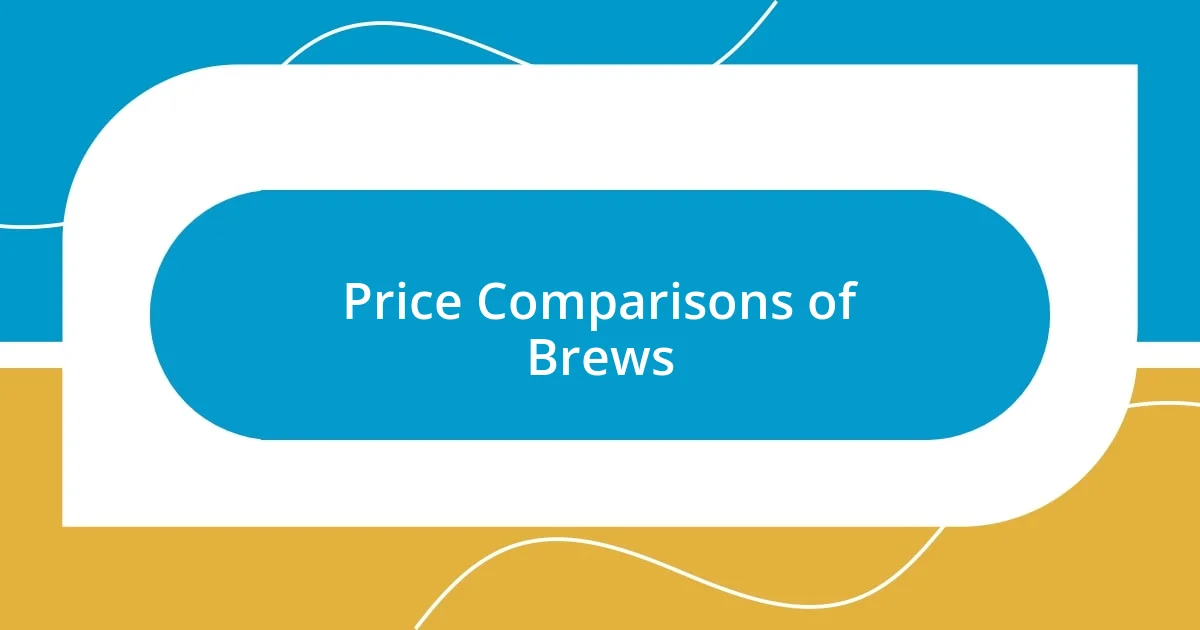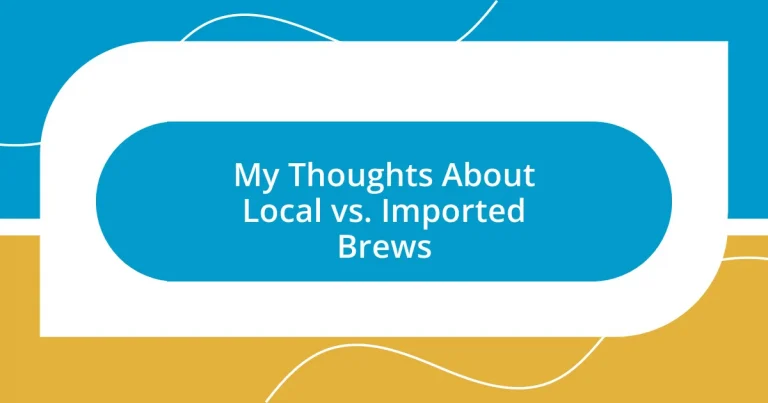Key takeaways:
- Local brews reflect regional culture and flavors, creating a unique sensory experience tied to the community’s identity.
- Imported beers offer a connection to traditional brewing practices and diverse global flavors, enriching the drinking experience.
- Sustainability is a growing focus in brewing, with local breweries often supporting local agriculture and minimizing waste, prompting consumers to consider their environmental impact.

Understanding Local Brewing Scene
The local brewing scene is truly a vibrant patchwork of creativity and craftsmanship. I remember my first visit to a local brewery, where I was welcomed not just by the aroma of freshly brewed hops, but by the passion behind each pint. It felt like stepping into a community, where the brewers were eager to share their stories and inspirations—don’t you find that kind of connection heartwarming?
What fascinates me about local brews is how they often reflect the region’s palate and culture. For instance, during one tasting event, I discovered a brew infused with local honey and wildflowers—an embodiment of the area itself! Have you ever tasted something so uniquely tied to its roots that it felt like you were drinking the landscape? It’s a sensory experience that makes each sip more than just refreshing; it’s a narrative.
Moreover, the interactions I’ve had with fellow enthusiasts at these breweries make the experience even more enriching. I’ve met people who can tell you the history of every ingredient and share personal stories connected to local flavors. This sense of community is what makes the local brewing scene so special; there’s a shared appreciation for the artistry involved. How often do we get to enjoy a drink that’s not only crafted with skill but also steeped in local tradition?

Advantages of Local Brews
When I think about local brews, it’s clear that one of the biggest advantages is the unique flavors that come from regional ingredients. The last time I visited a microbrewery, I was astounded by their exclusive seasonal offerings, like a pumpkin ale made from local farm pumpkins. It reminded me how personal and tailored these brews can be. Each pint tells a story that’s deeply rooted in the community.
Here are some key advantages of local brews:
- Freshness: Local breweries often use fresher ingredients, leading to vibrant and robust flavors.
- Cultural Connection: Many local brews reflect the culture and traditions of the area, creating a sense of place in each sip.
- Community Support: Purchasing local beers supports local economies and promotes entrepreneurship.
- Innovative Styles: Local brewers frequently experiment with unique styles and flavors, pushing the boundaries of traditional brewing.
- Accessibility: Often, local brews are more accessible and available in smaller quantities, making them easier to try.
I find joy in discovering these unique expressions in every brewery visit; it’s like uncovering hidden gems that represent the shared identity and creativity of the community. Each encounter feels like a personal adventure into the heart of local craftsmanship.

Exploring Imported Beer Varieties
Exploring different imported beer varieties can be an exhilarating journey across cultures. On one occasion, while visiting an international beer festival, I found myself captivated by a Belgian Trappist ale. The complexity of its flavors—rich caramel notes blended with zesty citrus—left me eager to learn more about the brewing traditions of Belgium. Have you ever experienced such an incredible layering of flavors that it transported you to another world?
What I’ve noticed with imported beers is their ability to narrate tales of their origins. For instance, each sip of a German lager transports me to the bustling beer gardens of Munich, where the tradition of brewing dates back centuries. The meticulous process they employ is impressive; every ingredient is selected with utmost care. It’s like tasting history in a glass—how often do you get to experience that kind of connection with another culture through a beverage?
Furthermore, the variety in beer styles and flavors available is astonishing. During my last tasting of imported brews, I was surprised by a Japanese rice lager, which offered a crisp, refreshing finish unlike anything I had tried before. This journey not only expands our palates but also enriches our understanding of global brewing practices. I often find myself wondering how many stories and experiences are captured in every bottle of imported beer.
| Country | Beer Style |
|---|---|
| Belgium | Trappist Ale |
| Germany | Lager |
| Japan | Rice Lager |

Price Comparisons of Brews
When I walk into a craft beer store, the price tags often tell a story of their own. I recall one visit where the local brews were priced around $10 for a six-pack, while imported options hovered closer to $15. That moment made me wonder—are we really paying for just the beer, or are we also investing in the experience and story behind each bottle?
I can’t help but notice the premium that sometimes comes with imported brews. I vividly remember sipping on a well-crafted Belgian ale that cost nearly twice as much as my go-to local pale ale. Was it worth the price? In that case, I’d say yes! The layers of flavor and the brewing tradition made the experience feel like an occasion rather than just a casual drink. Yet, I also appreciate how local brews can deliver amazing quality without the sticker shock.
Ultimately, the price difference prompts me to consider what truly matters in my preferences. Do I fancy the innovative flavors of local craft breweries or the rich history behind imported beers? I’ve realized that my budgeting often allows for a delightful balance between the two, enriching my exploration of the beer world.

Sustainability Considerations in Brewing
Sustainability in brewing is an increasingly vital conversation that I find myself drawn to. I remember the first time I visited a local brewery that sourced all its ingredients within a 20-mile radius. The brewer told me how this not only reduces transportation emissions but also supports nearby farmers, creating a community-focused ecosystem. Isn’t it heartwarming to think that every pint served is a collective step towards sustainability?
Moreover, the practices of waste reduction in brewing truly fascinate me. For example, when I toured a craft brewery, I saw how they repurpose spent grains as livestock feed. It struck me how innovative solutions can minimize waste and even lead to additional revenue streams. Have you ever considered how much potential exists in the scraps that we often overlook?
The issue of carbon footprint is another aspect that lingers in my mind. I once attended a beer tasting where the brewery highlighted their carbon offset initiatives, including planting trees for every barrel brewed. It was inspiring to see such dedication to environmental responsibility. It begs the question: how can we, as consumers, also champion these practices in our choices and support brewers that prioritize sustainability?

Personal Recommendations for Beer Choices
When it comes to personal recommendations for beer choices, I often lean toward local brews that showcase unique flavors. One evening, I tried a mango IPA from a nearby craft brewery, and the burst of tropical fruit transported me right to a sun-soaked beach. Can you imagine the thrill of discovering such vibrant, unexpected flavors without having to travel far?
On the other hand, I’m not one to shy away from a classic, imported lager. There was a time I shared a bottle of Pilsner Urquell with friends during a backyard BBQ, and the crisp, refreshing taste paired perfectly with grilled sausages. It sparked conversations about the brewing history behind that beer and brought an extra layer of enjoyment to our gathering. Have you ever experienced the magic of a beer that not only tastes great but also tells a story with every sip?
Ultimately, what I recommend is to consider the occasion and who you’re sharing your drink with. If you’re looking for something adventurous, lean towards local breweries that may provide exciting seasonal selections that surprise your palate. Conversely, if you want to unwind with friends over time-honored favorites, an imported brew can create a nostalgic atmosphere. Isn’t it fascinating how beer can help forge connections and create lasting memories?














